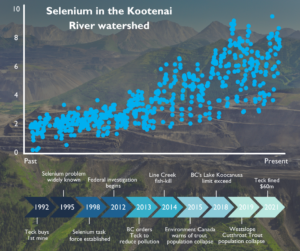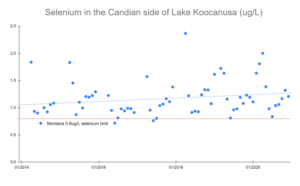Teck Resources Ltd. is a Canadian mining company that owns the Elk Valley open-pit coal mine complex. These five mountaintop removal coal mines in southeast British Columbia have been leaching selenium, a toxic element, into the transboundary Kootenai River watershed since the 1970s. On March 26, the multi-billion dollar company was fined $60 million for releasing selenium and calcite, another harmful substance, into the watershed. This is the largest fine ever handed out by the Canadian government under its Federal Fisheries Act.

Even after pleading guilty, Teck continues to portray the damages their mines are causing to transboundary waters and fish as minimal. The Idaho Conservation League and our partners consider these damages as incredibly harmful to a watershed that plays a central role in Idaho and Montana culture, history, water quality, aquatic life, and recreation. Below are a few of Teck’s arguments and ICL’s responses.
Teck: We’re conducting ongoing study and monitoring of water quality and aquatic health, including monthly sampling at over 100 locations.
Response: ICL is supportive of efforts to monitor water quality, but monitoring isn’t enough. The data Teck collects ends up highlighting the company’s inability to meet the standards set forth in their discharge permit, resulting in numerous and repeated violations.
Teck: Overall, monitoring confirms that the targets established in the Elk Valley Water Quality Plan for selenium and other substances are appropriate and protective of aquatic life.
Response: Teck is not meeting the targets (see permit violations above) nor are the targets established in the plan appropriate to protect aquatic life and the environment. Teck admitted in court to releasing harmful substances into the watershed in 2012. Since levels have continued to rise uninterrupted, the current levels are still not protective of aquatic life.
Teck: Based on a scientific understanding of selenium, the current concentrations are not expected to impact fish populations.
Response: Teck’s position seems to contradict a well-known selenium scientist, Dr. Dennis Lemly, who was an expert witness for Environment Canada’s investigation. In a summary of his findings, Lemly stated (p. 6),
“All Indications are that selenium pollution is having a substantial negative impact on westslope cutthroat trout in the Upper Fording River system. In the samples collected and analyzed by Environment Canada in 2012 and 2014, and submitted to me for review, the waterborne selenium is present at concentrations far above levels that cause bioaccumulation in the aquatic food-chain and excess dietary selenium Intake by fish, and cause associated reproductive toxicity in fish…”
Teck: An investigation into an identified population decline of Westslope Cutthroat Trout in the Upper Fording River is ongoing; however, preliminary findings indicate water quality constituents, including selenium, were not a primary contributor to the decline.
Response: If Teck believes the cause of the population decline is due to some other factors than their mines and water pollution, ICL requests that they share information about what those causes might be with us and other interested parties. So far, they have not. What we do know is that the upper Fording River is one of the most heavily polluted areas in this watershed, where pollutants like selenium and calcite are all found above levels that are considered safe by anyone, including Teck themselves.
Teck: Annual average levels of selenium in the Koocanusa Reservoir have been stable since 2014 and do not show an increasing trend.
Response: We’ve crunched the numbers and this simply isn’t true. Not only have selenium levels continued to increase since 2014 (rising 12 % in just four years), the levels are far above what Montana law says is protective of the watershed.

We still need your help! If you want to stop Teck from polluting our rivers, quickly send an email to the U.S. Department of State and ask for their help. Click below to send an automated email.

